Kelp forests and seaweed beds are a crucial part of the ocean ecosystem. They provide food, nursery grounds, and hiding places for diverse marine life. Ocean apex predators depend on these aquatic plants to nourish various prey species, which sustains the predators. In this guide, we’ll discuss 14 animals that eat kelp and seaweed, where they live, and the types of seaweed they consume.
Read on to learn more.
1. Green Sea Turtles (Chelonia mydas)

Adult green sea turtles eat various seaweed species, including red, brown, and green.
©Damocean/iStock via Getty Images
The only primarily herbivorous sea turtles as adults, green sea turtles (Chelonia mydas) feed on algae, seaweed, and seagrasses. With a finely serrated beak, green sea turtles can easily scrape seaweed off marine rocks and tear them from the sea floor.
One 2021 study found that green sea turtles in the northwestern Gulf of Mexico consume 33 species of red seaweed, 12 species of green seaweed, and eight species of brown seaweed, including kelp. The study also found that green sea turtles may consume specific types of seaweed at various times of the year. For example, the sea turtles in the study tended to destroy the most green seaweed in the spring.
2. Purple Sea Urchins (Strongylocentrotus purpuratus)

Currently, purple sea urchins are overgrazing significant portions of kelp forests off the coast of western North America. A human-caused decline in their natural predators has thrown off the ecosystem’s delicate balance.
©NatalieJean/Shutterstock.com
A lovely marine invertebrate species, the purple sea urchin (Strongylocentrotus purpuratus) inhabits shallow, coastal waters of the Pacific Ocean off western North America. Purple sea urchins are omnivorous but feed heavily on kelp and red seaweed. Their diet consists primarily of bull kelp and giant kelp. The lack of predators in kelp forests has caused overgrazing by sea urchins. Some researchers are proposing to reintroduce populations of sunflower sea stars (Pycnopodia helianthoides) into kelp forests, which predate on sea urchins, at a rate that can rebalance the health of the kelp forests.
3. Kelp Bass (Paralabrax clathratus)
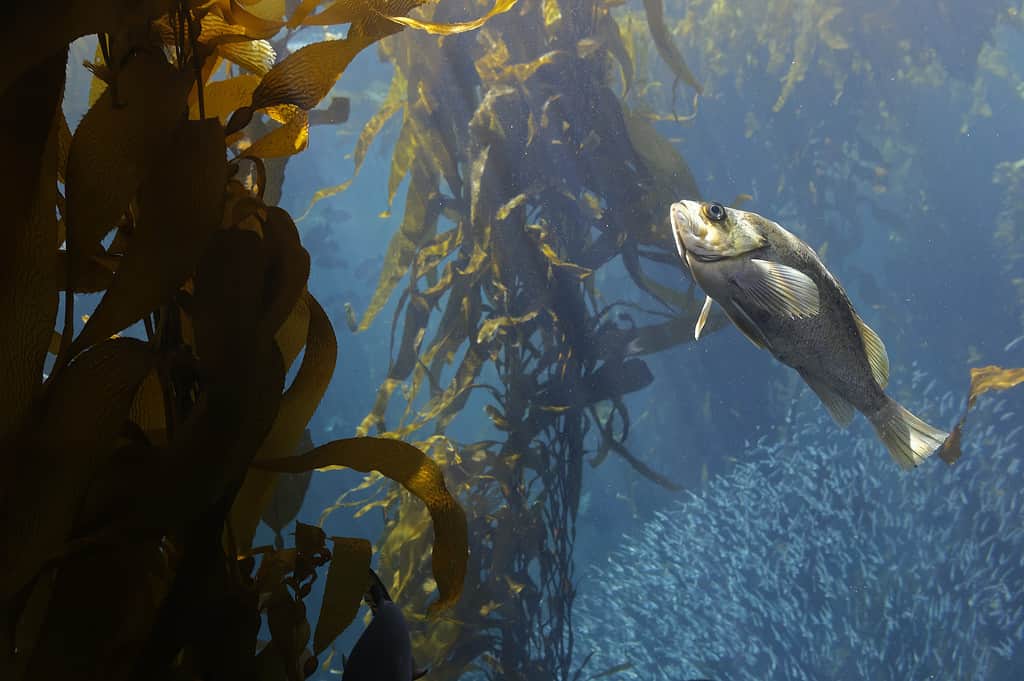
Juvenile kelp bass plays a crucial role in kelp forests’ health by eating kelp and kelp-consuming invertebrates.
©Gilberto Villasana/iStock via Getty Images
One of the most common sea basses to inhabit the coastal waters of southern California, the kelp bass (Paralabrax clathratus) plays a crucial role in the health of kelp forests. As juveniles, kelp bass eat both kelp and kelp-consuming invertebrates, aiding in their habitat’s delicate ecological balance. As adults, this species switches to feeding on benthic and pelagic fish, such as anchovies and perches.
4. Sea Hares (Anaspidea)

The color of a sea hare often reflects the type of seaweed it eats: red, green, or brown.
©svf74/iStock via Getty Images
In coastal waters with dense vegetation, sea hares (Anaspidea) are seaweed-eating marine snails. They occur in sheltered, coastal, temperate, and tropical waters worldwide. Interestingly, the color of the sea hare often depends on the type of seaweed it primarily ingests. For example, the California brown sea hare (Aplysia californica) feeds mainly on red and brown seaweed.
5. Common Brittle Star (Ophiothrix fragilis)

The familiar brittle star (
Ophiothrix fragilis) eats bits of seaweed through suspension feeding.
©johnandersonphoto/iStock via Getty Images
The diet of a brittle star (Ophiuroidea) is widely dependent on the species. For the familiar brittle star (Ophiothrix fragilis), phytoplankton (microalgae) and bits of seaweed (macroalgae) make up the primary diet. The typical brittle star primarily lives in rocky subtidal zones. It feeds as a nocturnal suspension feeder, passing phytoplankton and bits of seaweed into its mouth.
6. Opaleye (Girella nigricans)
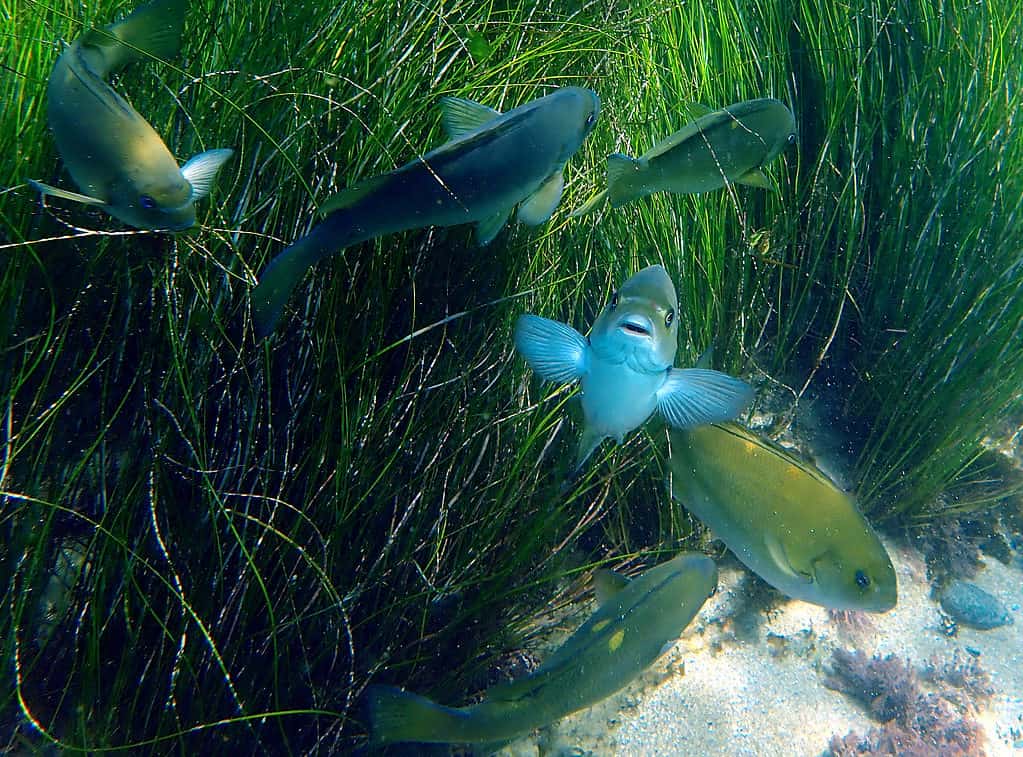
Seaweed in tidal pools makes up the bulk of the diet for juvenile opaleye. As adults, they also eat kelp.
©Gregg M. Howe/Shutterstock.com
The opaleye (Girella nigricans) is a perch-like fish living off North America’s western coast. Its preferred habitats are tide pools, kelp forests, and rocky intertidal zones, depending on its life stage. As juveniles, opaleye feeds almost entirely on seaweed in tide pools. As adults, these fish are omnivorous, eating kelp, other forms of seaweed, and small invertebrates.
7. Pacific Blue Tang (Paracanthurus hepatus)

Pacific blue tang nip and scrape small seaweed from coral reefs, ensuring a healthy ecosystem.
©bpperry/iStock via Getty Images
The lovely Pacific blue tang (Paracanthurus hepatus) inhabits many shallow waters across the Pacific and Indian Oceans. While omnivorous, most of their diet comes from seaweeds living in coral reefs. Pacific blue tangs can use their small and sharp teeth to pluck and scrape small seaweeds off the reefs.
8. Kelp Crab (Pugettia productus)
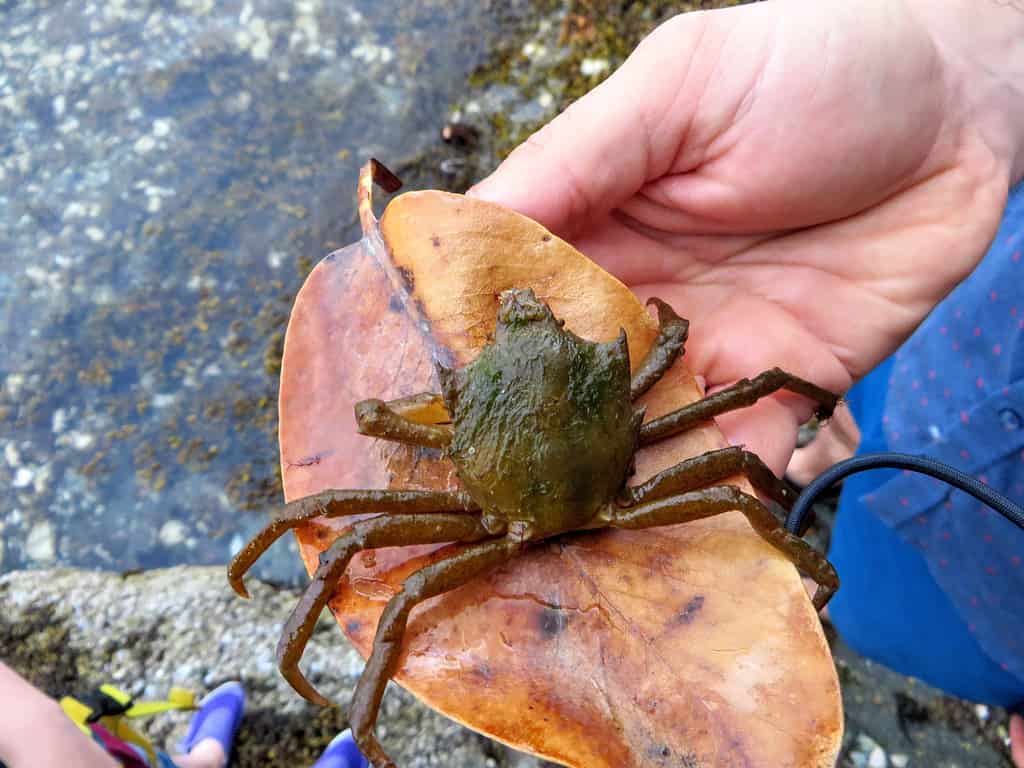
Seaweed, especially bull kelp, sea cabbage, and rockweed, comprise the bulk of the kelp crab’s diet.
©Chris Babcock/iStock via Getty Images
While many crabs feed on kelp and other types of seaweed, the kelp crab (Pugettia productus) relies heavily on seaweed for most of its diet. Ranging along the coastal waters of western North America, kelp crabs almost exclusively eat bull kelp, sea cabbage, and rockweed in the warm months. In the winter, when seaweed along much of their range becomes dormant, they become omnivorous.
9. Bristle Worms (Polychaeta)
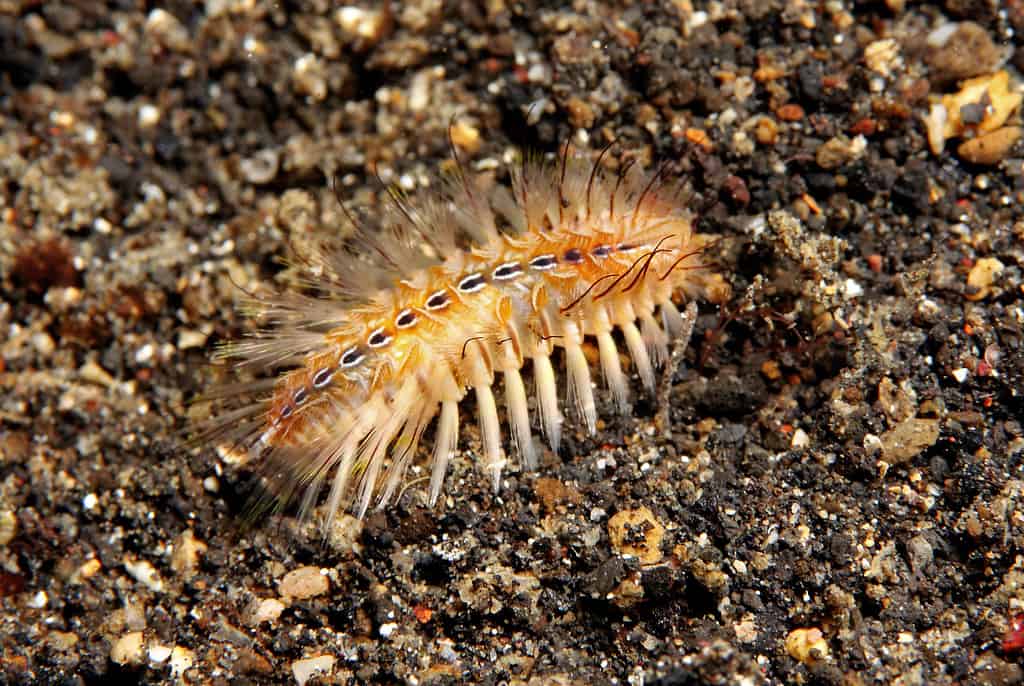
Brittle worms are one of the most commonly found invertebrates in kelp forests.
©John Anderson/iStock via Getty Images
Bristle worms of the Polychaeta family include at least 10,000 species inhabiting practically every habitat of the oceans, including deep-sea hydrothermal vents, the open sea, coral reefs, and kelp forests. Bristle worms are one of the most commonly found invertebrates in kelp forests. These worms feed on holdfasts of the kelp, which are root-like structures that secure the kelp to the sea floor.
10. Hermit Crabs (Paguroidea)
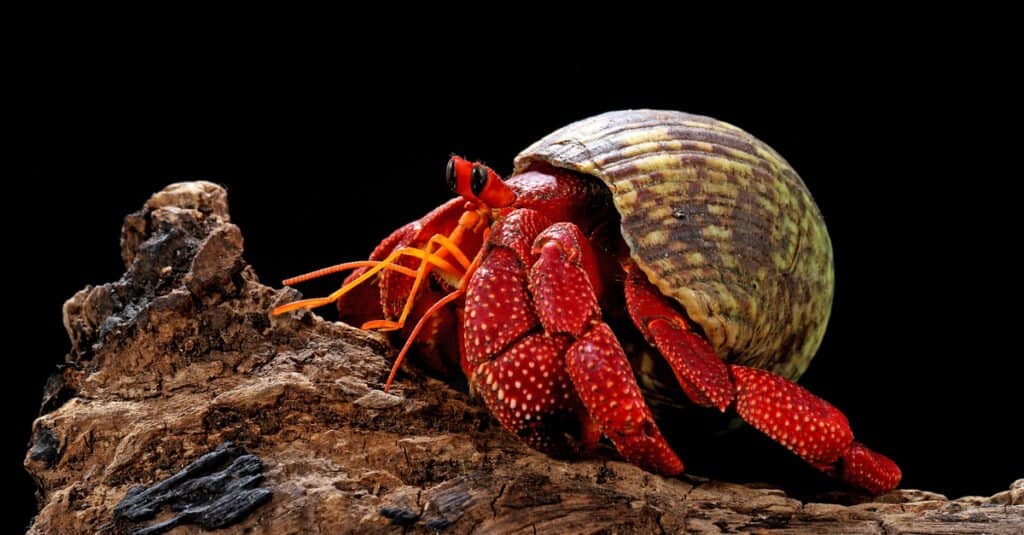
Hermit crabs have a wide-ranging diet and feed on bits of seaweed floating by their environment.
©Lauren Suryanata/Shutterstock.com
There are over 800 species of hermit crab in the Pauroidea superfamily. The vast majority are oceanic animals with a wide-ranging, omnivorous diet. Many species will readily chow down on a variety of seaweeds. In the wild, they typically ingest bits of seaweed that float by. Hermit crabs are often fed a diet mixed with dried seaweed in captivity.
11. Green-Boned Butterfish (Odax pullus)

The green-boned butterfish almost exclusively eats seaweed, especially kelp.
©Public Domain – License
One species of ray-finned fish that eats seaweed almost exclusively is the green-boned butterfish (Odax pullus). Inhabiting the coastal waters of the Southwest Pacific, the green-boned butterfish primarily eats brown seaweed, including kelp. They use their beak-like mouths to clip off pieces of seaweed. They then grind the seaweed with their strong jaws before swallowing.
12. Blue Perch (Medialuna californiensis)

The blue perch eat primarily kelp and red and green seaweed.
©Michael Bear / CC BY 3.0 DEED – License
Also known as the half-moon, the blue perch (Medialuna californiensis) is a marine ray-finned fish inhabiting western North America’s coastal waters. The common name of Halfmoon refers to the gently curved shape of their caudal fin (tail). They are most abundant in southern California. While omnivorous, the blue perch feeds primarily on kelp and red and green seaweed.
13. California Spiny Lobster (Panulirus interruptus)
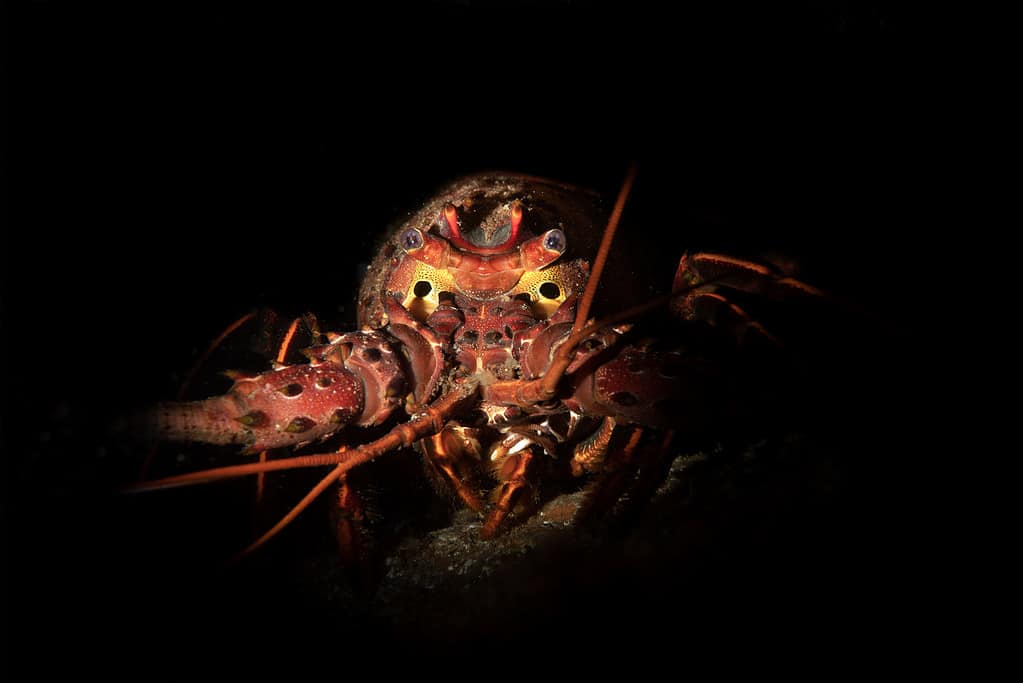
The spiny California lobster forages for bits of seaweed at night.
©joebelanger/iStock via Getty Images
One of approximately 55 species of spiny lobster found throughout the world’s oceans, the California spiny lobster (Panulirus interruptus) inhabits shallow depths off the coasts of southern California and Northern Mexico. The spiny California lobster is omnivorous, typically hunting and foraging at night. Their diet includes small fish, marine invertebrates, and bits of seaweed, including kelp. Importantly, they also prey on sea urchins, a crucial role in helping to keep kelp forests ecologically balanced.
14. White Abalone (Haliotis sorenseni)

An endangered species, the white abalone is a crucial part of healthy kelp forest ecosystems.
©Public Domain – License
The white abalone (Haliotis sorenseni) is a marine snail that occurs at depths of 50-180 feet and was once found in abundance throughout the coastal waters of southern California to northern Mexico. However, in 2001, the white abalone became the first marine invertebrate listed under the Endangered Species Act. The white abalone is a crucial architect of kelp forests. They don’t overgraze, but they eat enough of the holdfasts of kelp to create bare patches of rock, allowing a diversity of kelp species to grow.
The photo featured at the top of this post is © Gilberto Villasana/iStock via Getty Images
Thank you for reading! Have some feedback for us? Contact the AZ Animals editorial team.






